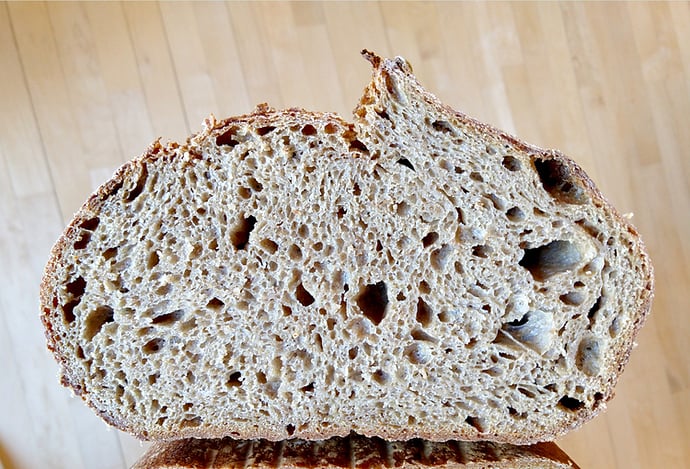Ahn,
I ONLY use home milled flour. However, it is not always freshly ground. I will grind about 10# and store it in a 40 degree frig. It is always used up in about 2 months.
Let me explain a complete ‘formula’ to make hydration clearer.
Step 1: Flour…let us say I use 1000g . If I am doing a long fermentation (using Einkorn whole grain flour), my TH will be 81%. (It could be as high as 87%.) I generally use 10% Total Hydration. This includes the liquid + the hydration in the starter. My starters are always 100% hydration as this makes determining the water content of the hydration easy…50% of total weight.
My formula would read: 100% Flour: 1000gr @ 81% TH (1000 x .81 = 810 gr water total…incl water in starter).
Since my starter is 10% of my flour, it will be 100gr starter (1000 x .10 = 100 grams). Since 50% of this starter is water, 50% of 100 grams starter is 50 gr. water.
My TH (total amount of water) is 810gr - 50 grams (starter hydration) = 760 grams of additional water needed.
Now I can write my ‘formula’
100% Flour: 1000g @ .81% TH (810grams liquid)
Starter: 100g (of which 50grams is water)
Liquid: 760 grams (810-50 = 760
Salt: 10 grams (since Einkorn is very resistant to stretch already, not much is needed)
Note that, in the above formula, I have no % before the starter, the liquid or the salt. To get those %s, I must divide the grams used by the total 1000gr of flour. Therefore, 100 grams starter/1000 grams flour = 10%. 760grams liquid/ 1000 grams flour = 76%. 10 grams salt/1000grams Flour = 1%. I will rewrite my formula as:
100%: Flour: 1000grams @ 81% TH (1000x.81=810grams T.H.)
10%: Starter: 100grams (of which 50%…50 grams…is water)
76%: Liquid: 760grams additional water
1%: Salt: 10 grams
One other thing to note…Most formulas would simply state the hydration as 760 grams and make assumptions about how much water is in the starter. That missing 50 grams of water can make all the difference between success and failure. For this reason, about 24 hours before I need my starter, I take a small portion from my ‘starter jar’ and put it into another container. Then, I feed this small amount (usually ~ 25 grams and equal ratio of water and flour. Notice that I am NOT ASSUMING that my original starter is still 50%:50% since dehydration could have decreased the hydration! By taking a small amount from the ‘starter jar’, I am insuring that my levain/starter for the dough is 100% hydration. Hope this helps.
BTW…The actual starter/levain used for long fermentation varies according to the length of time you want to allow the dough to ferment. For me (in my home), 10% starter/levain allowed a 9 hour fermentation (with time to spare for shaping and proofing). This allowed me to leave it at room temp overnight (~70 degrees F). Obviously temp (lower or higher) would have either increased or decreased the fermentation time. Also, increasing/decreasing the starter/levain would have increased or decreased the fermentation time. This 10% just happened to be perfect for me. Many times, I only want a short fermentation (4-5 hours). In these instances, my starter/levain would be much larger…closer to 54%.
 The rest being King Arthur Bread Flour. Hydration is 73%. Should I only do no knead if I want to use my Emmer Farro wheat? Should I decrease hydration? Not autolyze the EF? Any suggestions will be much appreciated. Thanks. Oh BTW all loafs besides
The rest being King Arthur Bread Flour. Hydration is 73%. Should I only do no knead if I want to use my Emmer Farro wheat? Should I decrease hydration? Not autolyze the EF? Any suggestions will be much appreciated. Thanks. Oh BTW all loafs besides 

